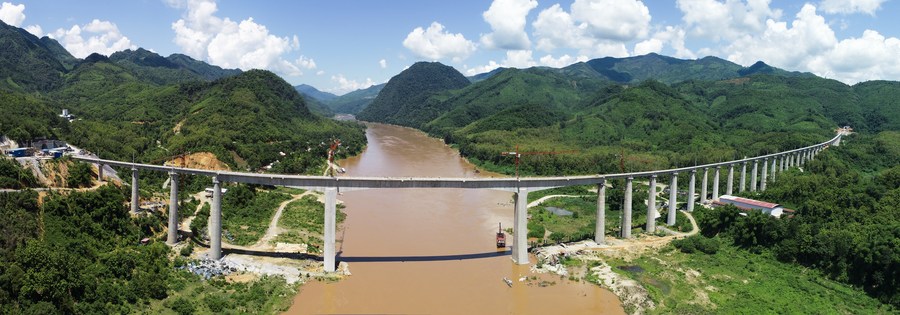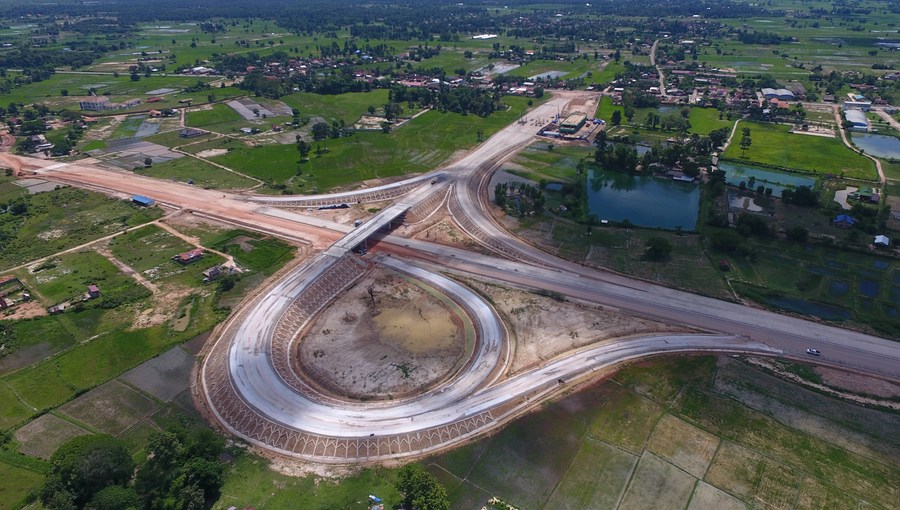New report reviews China's 5-year cooperation with Mekong countries

Aerial photo taken on July 24, 2020 shows the China-Laos Railway's Ban Ladhan Mekong River Super Major Bridge in Laos. (Photo by Pan Longzhu/Xinhua)
The Blue Book of the Lancang-Mekong Cooperation (LMC) 2020 was released Tuesday in southwest China, marking the fifth anniversary of the establishment of the LMC mechanism.
The report, compiled by Yunnan University, reviews the progress, problems and development trends of the LMC since 2019. It analyzes collaborations in specific areas including public health and the fight against drugs.
It said since 2019, cooperation between the six countries has blossomed in areas including connectivity, industrial capacity, cross-border economy, water resources, agriculture and poverty reduction.
Cooperation has now extended to new fields such as the digital economy, environmental protection, health and customs, while small and medium-sized projects in Mekong countries have increased in number and focused more on technology, hygiene and other livelihood-related areas, said the report.
The LMC mechanism was launched by six countries -- China, Cambodia, Laos, Myanmar, Thailand and Vietnam -- in 2016. It derives its name from a river that is called Lancang in China and Mekong in the five other countries.
The report's launch was part of a symposium on the LMC, which kicked off in Kunming, capital of Yunnan Province, with attending officials and scholars from China and the Mekong countries speaking glowingly of the regional cooperation mechanism.
"As the COVID-19 pandemic is still hitting the world, the LMC countries are expected to strengthen public health cooperation and focus on work resumption, water management and the improvement of people's livelihood," Liu Zhi, director of the Center for LMC Studies under Yunnan University, said in her opening remarks at the symposium.
Liu said while the pandemic plunged the region into an economic downturn, it has also injected new momentum into regional integration by bringing geo-economic partners closer together.

Aerial photo taken on July 6, 2020 shows China-Laos expressway under construction in Vientiane, Laos.(Photo by Liu Ailun/Xinhua)
WIDE-RANGING COOPERATION
Htun Aung Kyaw, consul general of Myanmar in Kunming, said under the LMC, China and Myanmar have implemented wide-ranging cooperation from joint river patrol to agriculture to poverty reduction.
"I believe the mechanism is a beneficial cooperation framework for the development of all the member countries," he said.
Traffic infrastructure has been a major beneficiary of the LMC mechanism.
In September 2017, the whole China section of the 1,800-km-plus Kunming-Bangkok highway became an expressway, shortening the transportation time of goods between the two cities to about 40 hours.
The expressway has transformed the life and business of Su Congming, a wholesaler who has been selling imported fruits at the Jinma-zhengchang fruit market since 2003.
At the start of his business, it took about five days for Thai fruits to arrive at the market, he recalled, adding that nowadays fruits are fresher while transportation fees are lower.
The market is one of China's major centers for the distribution of fresh tropical fruits from South and Southeast Asian countries. Every day, thousands of tonnes of fruits are distributed from here to across China.
"Now, we sell five to six times more fruits than we did a decade ago. Before this year's Spring Festival, we sold more than 40 tonnes of longan imported from Thailand every day," said Su.
The Kunming-Vientiane railway linking China with Laos is scheduled to be opened in December this year, said Lu Dongfu, board chairman of China State Railway Group Co., Ltd. Upon completion, it will slash travel time between the two cities to within one day.
"We are developing an electric multiple units (EMU) train running at 160 km per hour, based on China's (technological) standards, adapting to the conditions of China-Laos railway lines and reflecting the cultural elements of the two countries," said Lu.
Other initiatives pushed ahead under the mechanism included streamlining and integration of customs, logistics and foreign exchange management to facilitate cross-border trade.
Water resources cooperation has also been prioritized under the LMC framework, with officials pointing to the launch of a website for sharing water resources information among the six countries in November 2020. The website is expected to help Lancang-Mekong countries better tackle climate change and natural disasters such as floods and droughts.
China has officially provided the Mekong countries with the river's hydrological information during the dry season starting from Nov. 1, 2020, according to E Jinping, former minister of water resources.
"The Lancang-Mekong countries share the same river water, as a community with a shared future and enhancing the foundation of development and prosperity together," said Wang Yiwei, a professor with Renmin University of China.
By Xinhua writers Zhao Jiasong, Li Huaiyan, Yao Bing